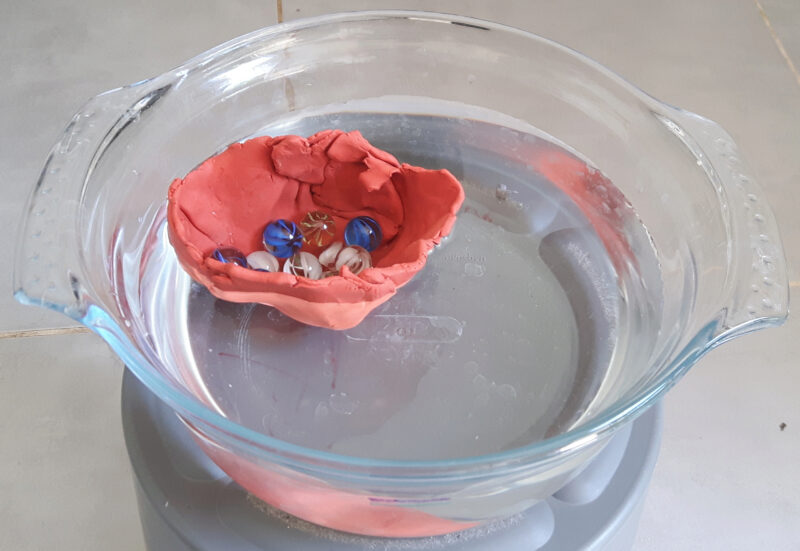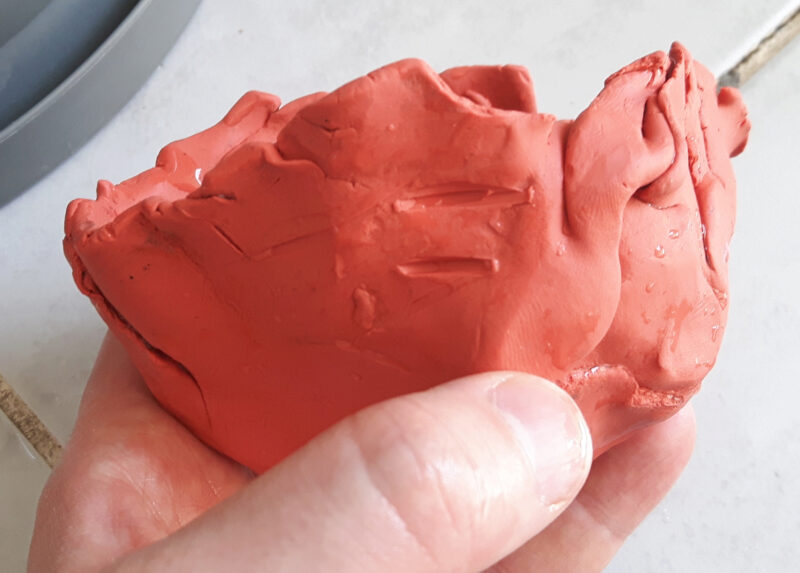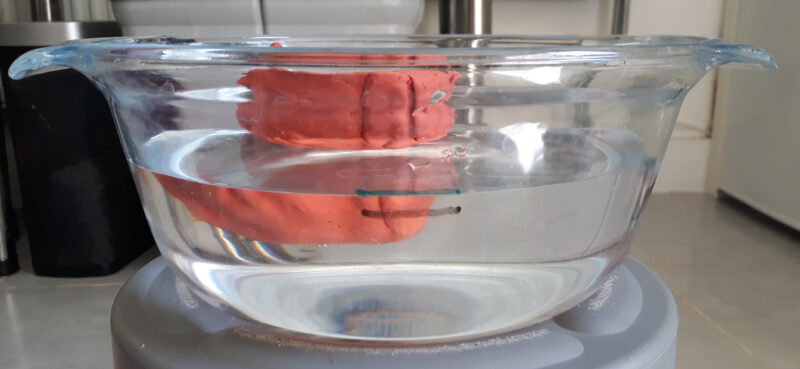Early-Years Science: Buoyancy and Displacement
Setup time: ~5mins
Run time: 15-30mins
Age range: 3+
Goals
Investigate how buoyancy and displacement are related.
Notice correlations and connections between different phenomena.
You will need
- 1 large, waterproof container. Transparent if possible, but any container will do. E.g. a bucket, basin, large mixing bowl, or watertight box. A bath or sink will also work fine.
- Something boat-like: e.g. a toy boat or a small plastic tub. Plasticine or play-dough to shape into a boat will also work fine.
- Waterproof marker pen. (A normal felt pen will do if you don't have a waterproof marker.)
- Small weights, E.g. pebbles or marbles.
- A balloon.
How to do the experiment
Setting up (about 5mins)
- Set things up somewhere where it doesn't matter if some water gets spilled. E.g. outside, or on a tiled floor, or on a table with cloths or towels laid on top.
- Fill the container with water. (Children usually love helping with this bit, so you could get them to help you by filling small jugs or bottles and having them pour it into the container.)
Buoyancy and displacement (5-20mins)
- Explain to your children that you're going to mark how high the water is. Use the waterproof marker to draw a line on the container, marking the level of the water. (If the container is transparent so you can see the water level through it, mark the water level on the outside. If not, mark it on the inside.) If your children are able to, let them do this themselves (helping them as necessary).
- Let your children place the boat in the water so that it floats.
- Ask your children if they notice anything different (see What to talk about, below).
- Draw a line on the boat to mark the level of the water. (Score a line in the side of the plasticine or playdough if that's what your boat is made of, otherwise use the marker to draw a line.)
- If the water level in the container has risen high enough to be well above the marker line you drew at the start, draw a new line on the container to mark the new level of the water.
- Let the children drop one of the weights into the boat.
- Ask then if they notice anything different (see What to talk about, below).
- If the water level in the container has risen high enough to be well above the last maker line you drew, draw a new line on the container to mark the new level of the water.
- If the water level on the boat has risen high enough to be well above the last line you drew, draw or score a new line on the boat to mark the new level of the water.
- Repeat this with the remaining weights, until the boat sinks or you run out of weights.
Feeling buoyancy for yourself (5mins)
- Inflate the balloon, and put the balloon in the water.
- Have your children push down on the balloon.
- Ask them what they feel (see What to talk about, below).
- Ask them if they notice anything that's changed (see What to talk about, below).
What to talk about
Buoyancy and displacement
- Ask your children if they notice anything changing as you add the boat to the water, and then when you add the weights to the boat.
They may not notice the water level changing at first. And they may notice other things that have changed, not listed here. The important thing is to encourage them to observe carefully and notice as many things as possible! Let them observe as much as possible on their own, first. Then, if needed, encourage them to look at the level of the water. Prompt them to think about how the water level now compares to the water level you marked previously.
- Ask them if they notice anything about the water in the container.
- Where was the water up to before?
- Where was the water up to when you marked the line?
- Is the water above or below the line you drew before?
- Has the water level gone up or down?
- Ask them if they notice anything about the level of the water on the boat
- Is the water higher up the boat than before?
- Is the water above or below the line you drew before?
- Is the boat lower in the water than before, or higher?
Once you have observed that the boat sinks lower in the water as you add weights to it, and the water level in the container rises, it's time to think about how the weights, water level on the boat, and water level in the container are all connected!
- Ask them why the boat sinks lower in the water as you add weights to it.
- Do they think the boat is getting heavier as they add the weights?
- Do they think a heavier boat will sink lower in the water, or will it float more?
- What does the boat do to the water as it sinks lower?
- Does it push the water out of the way?
- Where does that water go?
- Why do they think the water level in the container has gone up?
Feeling buoyancy for yourself
- Ask your children if they can feel the water pushing back.
- Does it push back more strongly or less strongly as they push the balloon deeper into the water?
- Ask them if they notice anything about the water in the container, as they push on the balloon.
- Does the water level in the container go up or down?
- As they push on the balloon, what does it do to the water?
- Does it push it out of the way?
- Where do they think the water goes?
- Why does the water level in the container go up?
What's going on
Buoyancy and displacement
A boat floats because it is held up by the force of the water pushing it upwards. As the boat sinks into the water, it pushes the water out of the way and the water pushes back. This force is called buoyancy.
The strength of this buoyancy force increases as more water is pushed out of the way (displaced). (See also EYS_floating_and_sinking.html.) As you add weights to the boat, the boat gets heavier, and the force of gravity pulls it lower in the water. This pushes more water out of the way, so the buoyancy force increases, until it is strong enough to hold up the heavier boat with the weights in.

You can see that the boat sinks lower in the water as more weights are added, by comparing the lines you marked on the side of the boat, marking where the water level came up to as more weights were added.

The level that the water comes up to on a ship is called the waterline. Real ships have lines marked on the side, called load lines or Plimsoll lines, to indicate how much weight they are carrying. If the water is up to the top line, the ship is carrying the maximum amount of weight it can safely carry.

Figure 1: By Brinki, CC BY-SA 2.0.
The water that the boat pushes out of the way can't just disappear – it has to go somewhere! For the water in the container, the only place it can go is to rise higher in the container and fill up more of it. You can see the water level in the container rising as you add weights to the boat, by comparing the lines you marked on the side of the container as you added more and more weights to the boat.

So, as you add weights to the boat, the boat sinks lower in the water. As the boat sinks lower, it pushed more water out of the way. That water has to go somewhere, so it fills up more of the container and the water level rises.
Feeling buoyancy for yourself
You can feel for yourself the buoyancy force from the water pushing back, when you push the balloon into the water. As you push the balloon, the water level in the container rises, and the force pushing back on the balloon gets stronger.

The harder you push against the balloon, the deeper it gets submerged in the water, the higher the water rises in the container, and the stronger the force you can feel pushing back.1 1Push hard enough, and you might displace enough water to overflow the container! Hope you remembered to lay out those towels!
Thinking like a scientist
Noticing correlations
How do scientists come up with new theories and hypotheses about how the world works? Often, it's by noticing different things that seem to happen together. Whenever more weights are added to the boat, the boat sinks lower in the water. Whenever the boat sinks lower, the water level in the container goes up. Noticing this correlation gives us a hint that there might be some connection between these three things: adding weights to the boat, the boat sinking lower in the water, and the water level in the container rising.
The balloon confirms the correlation we noticed with the boat. As we push the balloon lower into the water, the water level in the container rises. It also lets us notice another correlation: the deeper we push the balloon into the water, the harder the balloon pushes back.
You may have heard the phrase: "Correlation does not imply causation." When two things always seem to happen together, it's extremely tempting to believe one causes the other. E.g. that the boat sinking lower in the water is what causes the water level to rise.
But how do we know it isn't the other way around? Maybe it's the water level rising that causes the boat to sink lower. Or maybe neither one caused the other. After all, what really happened is that we added weights to the boat. Maybe it's adding weights that makes the water level rise, and nothing to do with the boat sinking lower.
In this case, our intuition is right: it is the boat sinking lower in the water that makes the water level rise, and not the other way around. In fact, we can easily test this: try pouring more water into the container. The water level in the container rises. Does the boat sink lower in the water?
But it's important to realise that, just because two things seem to always happen at the same time – they are correlated – it's not necessarily true that one causes the other.
2
2For example, the number of lawyers in Hawaii is very closely correlated with the consumption of mozzarella cheese in the US. When mozzarella consumption goes up, the number of Hawaiian lawyers goes up. When the number of lawyers decreases, mozzarella consumption decreases.
But it's very unlikely that eating more mozzarella cheese causes more layers to start work in Hawaii! (Or that a new lawyer starting work in Hawaii causes people to eat more mozzarella.)
This correlation is probably explained by the increase in mozzarella consumption, and the increase in the number of Hawaiian lawyers, both being caused by something else in common. Such as the US economy growing.
Explaining connections
Noticing correlations is only the starting point. Spotting that the water level in the container rises when we add weights to the boat, doesn't explain why this happens. But once we notice this connection, we can start to come up with possible explanations.
If all we noticed was that the water level rose when we added weights to the boat, we might struggle to come up with any plausible explanation. But noticing the other correlation is helpful here: the boat also sinks lower as the weights are added,
We know from experience that heavier objects get pulled downwards harder by gravity: a heavy weight is harder to lift than a light one. So might expect the boat to be pulled downwards harder by gravity as we add weights to it, and sink lower in the water. But as it sinks lower in the water, it must be pushing the water out of the way. That water has to go somewhere! The only place it can go is to fill up more of the container. So the water level in the container rises.
It's important to realise that we don't know that this is the right explanation. It's a hypothesis. In science, coming up with a possible explanation – a hypothesis – is only the beginning. The next step is to think about how to test this hypothesis, to see if it's right or not. The Floating and Sinking experiment is a good example of testing hypotheses.
The the concepts of correlation and causation are too complex to explain to young children directly. But learning to observe closely, learning to spot everything that's going on, and thinking about how these might be connected, puts these concepts into practice. Which is more important than knowing what they're called!
Feedback
If you try this experiment with your own children, I'd be very happy to hear feedback on what worked well, what didn't work well, whether it was easy to follow, whether the explanations were clear, or anything else. I will continue to edit and improve this page over time. You can post public feedback on this page using the form below, or send me an email.
Leave a comment
All comments are moderated. Clicking submit will open your email client and let you send your comment by email. By submitting your comment you agree to license the content under a Creative Commons Attribution-ShareAlike 4.0 International License.